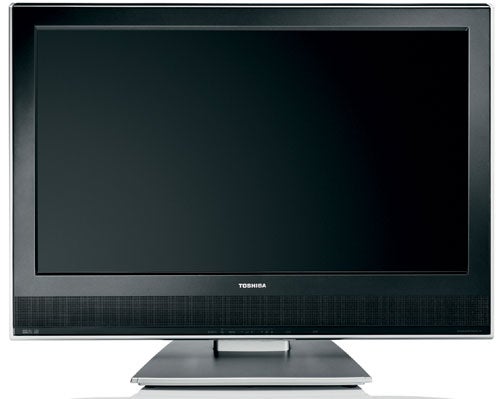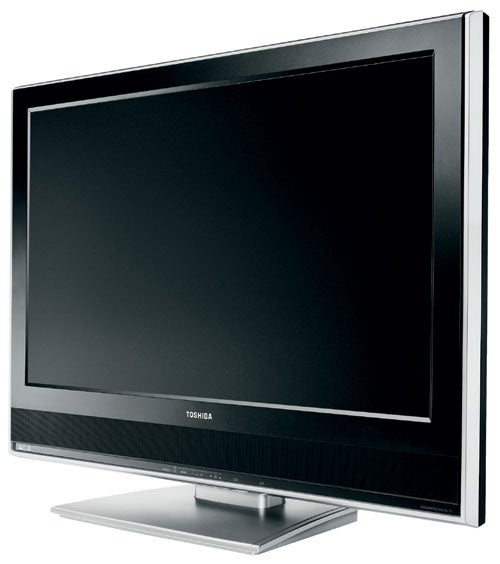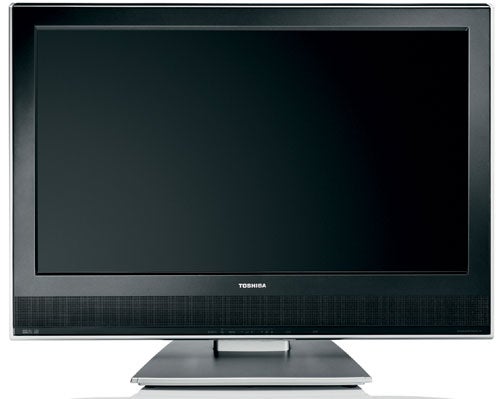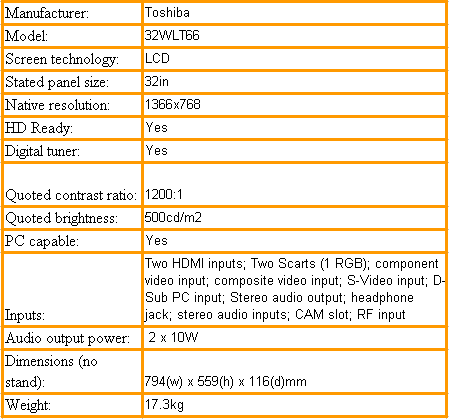Toshiba 32WLT66 32in LCD TV Review
Toshiba 32WLT66 32in LCD TV
Toshiba's new range of LCD TVs looks set to take the market by storm.

Verdict
Key Specifications
- Review Price: £1100.00
Toshiba was honest enough to admit at a recent press product launch that it was rather late arriving at the LCD TV party. Yet it’s also bullish in its belief that its latest LCD range completes in style the game of catch up it’s been playing with other, more experienced LCD brands. So we thought we’d better put this belief to the test by checking out Toshiba’s new 32in 32WLT66 – part of the company’s new ‘REGZA’ range.
Things start promisingly with the 32WLT66’s dramatic looks. It’s a really quite heady concoction of matt black, sharp grey trim and subtle curves that’s a million miles from the slightly drab look of previous Toshiba LCD ranges.
There’s a neat trick to its design, as well. For in a moment of inspiration Tosh’s design team decided to build an optional (£150) subwoofer for the set that can be attached to its rear using the holes provided for wall-mounting. Clever.

Connectivity, meanwhile, also makes a good first impression by including two HDMI sockets. Such dual digital support is still rare in the TV world despite the fact that numerous digitally connecting sources will likely be clamouring for socket space in the coming 12 months.
As demanded by the AV world’s HD Ready specifications, the 32WLT66 also carries a component video input – the likely high definition home for an Xbox 360 for many of our readers. A 15-pin D-Sub connector permits PC connection, meanwhile, with the only slight connection disappointment being the provision of just two SCART sockets.
The 32WLT66 completes the HD Ready journey started by its connections with a native HD-friendly resolution of 1,366 x 768 and compatibility with the key 720p and 1080i signals. In common with the vast majority of current LCD TVs, however, this set can’t take 1080p feeds.
It’s worth adding here that Toshiba’s bigger versions of the WLT66 – the 47in 47WLT66 and 42in 42WLT66 – will have a higher native resolution of 1,920 x 1,080 when they launch in the next few weeks. They still won’t be 1080p compatible, but their extra resolution arguably makes them better equipped to cope with the full 1080i HD broadcasts Sky recently announced it will be showing as standard on its upcoming HD service. Of course, though, these 1080-line big boys will set you back a good few quid more than this 32in model, as well as probably not being practical in size for most ‘normal’ living rooms.
The most key feature of the 32WLT66 beyond what we’ve already covered is its built-in digital tuner, complete with 7-day electronic programme guide support. You can store up to eight recording events from this EPG, too, and add subscription services via a provided card slot.

Every ambitious LCD TV worth its salt these days has some fancily named picture processing system up its sleeve. And on the 32WLT66 this system goes by the name of Active Vision LCD. As with most rival systems, Active Vision uses processing algorithms to improve a variety of picture elements, including colour saturations, motion, contrast and sharpness/detailing. But all processing algorithms certainly aren’t equal, so we’re hoping that Toshiba’s go about their improving business without causing all the unwanted side effects experienced with some rival processing systems.
A fiddly operating system comprising some rather tortuous menus and an occasionally unresponsive remote control offers up a reasonable set of further features. Particularly interesting to our readers will likely be the ‘3D Colour Management’ option, which subtly shifts the TV’s colour emphasis to make it better suited for PC use. You can also manually tweak the red, green, blue, yellow, magenta and cyan colour components, and make movement look smoother during DVD movies by selecting a Cinema Mode.
So far Toshiba’s claim that it’s caught up with the LCD early birds seems fair. And happily this impression is reinforced in spectacular fashion by the 32WLT66’s outstanding picture quality.
Grabbing our attention first – and holding it tight – are the set’s colours. We’re now getting used to seeing intense colours from LCD TVs, but those of this Toshiba model are a notch more vibrant than most. What’s more, this colour intensity is achieved without such colour noise or messy edging, and without letting the colour tone become unrealistic and ‘cartoony’.
Part of the reason the colours look so dynamic is that the screen’s black levels are also exceptional by LCD standards. As well as throwing bright colours into starker relief, this also gives the picture more depth – especially as the dark areas on this Toshiba aren’t the empty shells they so often are on rival LCDs, instead showing up plenty of subtle colour and detail effects.

Yet more good news comes with the 32WLT66’s sharpness. High definition looks stuffed full of detail and texture, as well as looking crisper than a Walker’s tasting convention. But PAL standard definition broadcasts via the digital tuner also appear unexpectedly clean and clear, doubtless thanks to the detail-boosting antics of Toshiba’s Active Vision processing. What’s more, Active Vision does its thing without throwing up any unwanted digital processing side effects such as smearing or edge noise.
Talking of smearing, motion on the 32WLT66 is largely free of this common LCD glitch. Even a full-tilt Thierry Henry presented the set with little problem during our tests.
Not everything about the 32WLT66’s pictures is perfect, though. For instance, while black levels are a cut above those of most rivals, just occasionally really dark images adopt an ever-so-slightly bluish hue. Also during some dark scenes, the generally impeccable colour scheme loses a fraction of its naturalism. Finally, actors’ skin can look a touch smooth and ‘waxy’ at times. But we only bother you with these really quite minimal complaints because it’s our job to do so. Chances are that they’ll hardly bother a ‘normal’ TV viewer at all.
The 32WLT66’s audio performance isn’t quite as inspiring as its pictures. There’s a sense that something is missing from both the highest and lowest extremes of the audio range, leaving the mid range feeling a bit overloaded. But this overloading isn’t severe enough to cause speech to sound muffled or action scenes to sound unduly harsh. Plus, of course, if the bass really doesn’t feel powerful enough for you, you could always add that optional subwoofer speaker we mentioned earlier…
”’Verdict”’
With the 32WLT66, Toshiba’s game of LCD catch-up is definitely over – and it’s won. Its connections are unusually flexible, its picture performance is easily as good as anything we’ve seen from any other LCD manufacturer to date, and when you consider all this, its price tag looks pretty darned reasonable, too.

How we test televisions
We test every TV we review thoroughly over an extended period of time. We use industry standard tests to compare features properly. We’ll always tell you what we find. We never, ever, accept money to review a product.
Trusted Score
Score in detail
-
Value 9
-
Image Quality 9
-
Sound Quality 8

